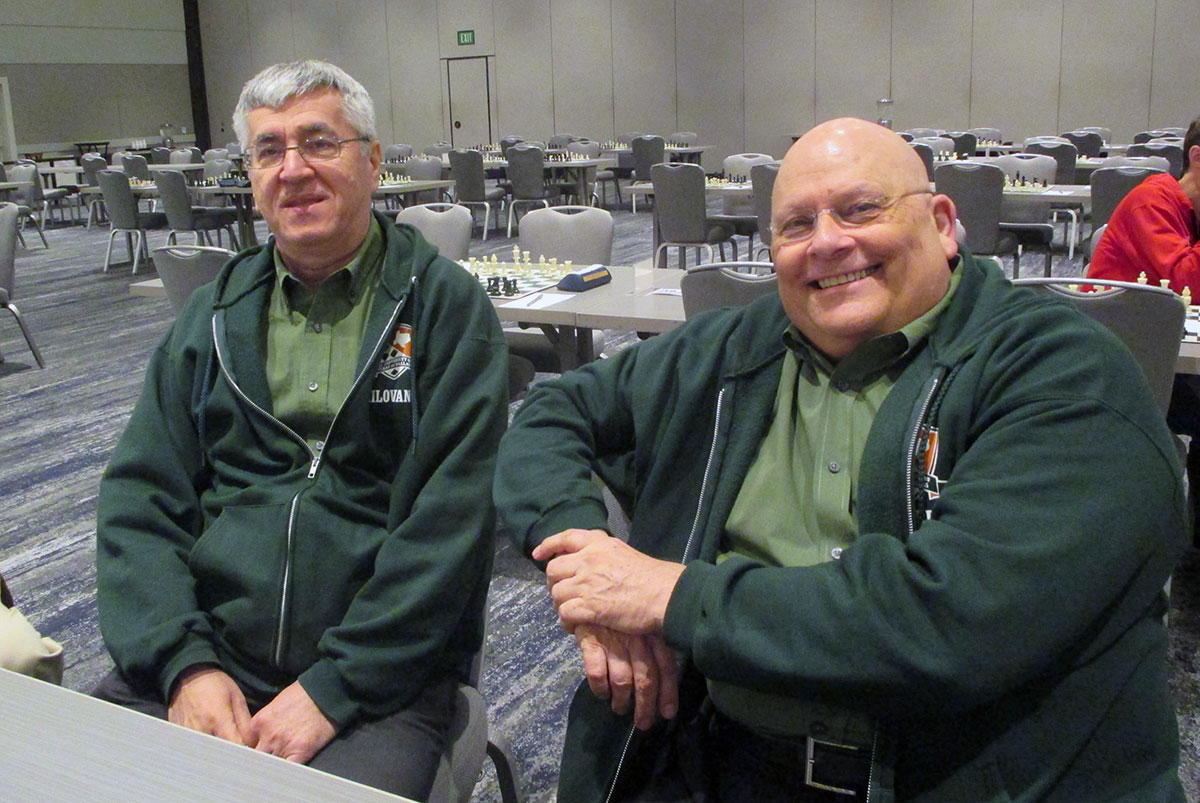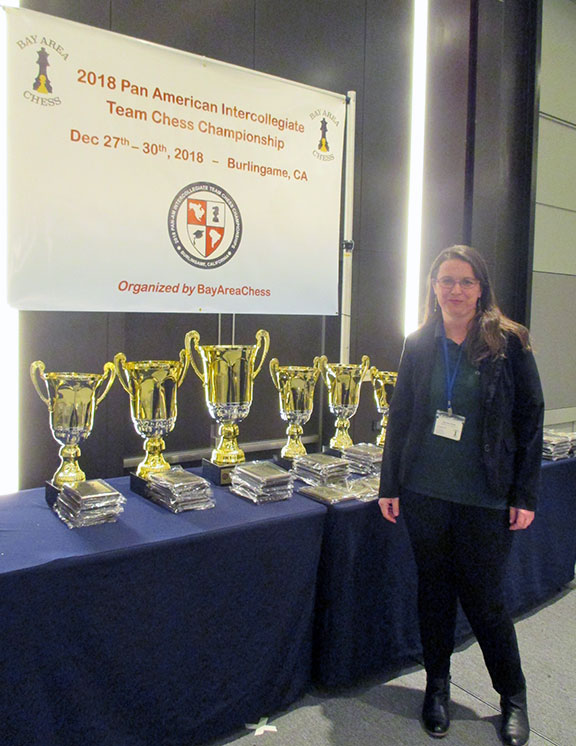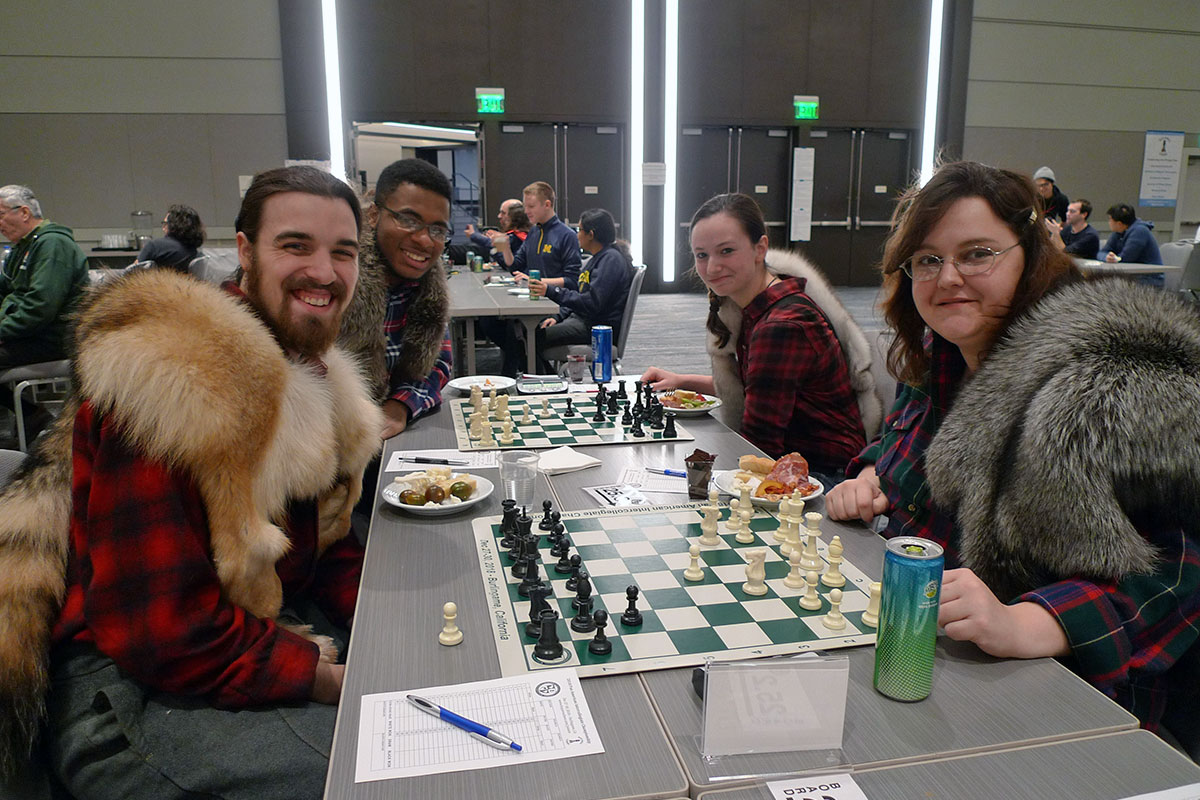The Pan-American Intercollegiate Team Chess Championships (Pan-Am) is open to chess teams from post-secondary schools in North America, Central America, South America, and the Caribbean. The Pan-Am is held annually between Christmas and New Year’s Day. This year’s Pan-Am has 230 players competing on 53 teams, a decrease from last year’s 58 teams. Each Pan-Am team has four players (called “four boards”) and may have up to two alternates.
At the end of six rounds in San Francisco, four of the U.S. schools will qualify for the President’s Cup, to be held April 6th-7th, 2019, at the Marshall Chess Club in New York City. If two teams from the same school (college or university) finish in the top four, then another school high in the standings qualifies. Therefore, some contenders have entered multiple teams to increase their chances to qualify for the President’s Cup. The University of Texas at Dallas (UT Dallas) Chess Program Director Jim Stallings said, “We have four very good teams entered, and UT Dallas expects to do well. It will not be easy; others also have very strong teams entered.” Round 1 went well for UT Dallas, with its top three teams scoring 12 wins and its fourth team scoring 3½ of 4. However, other top schools’ teams also won their round 1 matches, with similarly-lopsided margins.

Rade Milovanovic and Jim Stallings from UTD
For the Pan-Ams, the top teams travel with chess coaches, often full-time employees of their universities. The chess coach for UT Dallas, IM Rade Milovanovic, is making his last appearance at the Pan-Am. He is retiring in January after 20 years of college chess coaching. The teams he has coached have finished first, or tied for first, in the Pan-Am ten times, a record for a college chess coach. His departure means there is a job opening: If you are an IM or GM, and have experience coaching, you can apply to work for UT Dallas.
 The Executive Director of BayAreaChess, Dr. Judit Sztaray (pictured), is the Chief Organizer of the 2018 Pan-Am. She describes her role as “meeting and greeting all the participants, making sure everyone is comfortable, and that conditions are fair and safe and no cheating occurs.” Also making sure the tournament runs smoothly is Tom Langland, the Chief Tournament Director who holds the titles of International Arbiter, International Organizer, and National Tournament Director (NTD).
The Executive Director of BayAreaChess, Dr. Judit Sztaray (pictured), is the Chief Organizer of the 2018 Pan-Am. She describes her role as “meeting and greeting all the participants, making sure everyone is comfortable, and that conditions are fair and safe and no cheating occurs.” Also making sure the tournament runs smoothly is Tom Langland, the Chief Tournament Director who holds the titles of International Arbiter, International Organizer, and National Tournament Director (NTD).
All Pan-Am players record their games on paper, carbon-copy scoresheets. The players keep the yellow (bottom) copies of scoresheets, while the organizers collect the top (white) copies. Until those scoresheets are entered into a database, one can only study the games which are transmitted via DGT boards. During each round, the top three matches (of four boards each, thus 12 games) are broadcast via CalChess Live. STD Jordan Langland is operating the DGT boards. Sztaray noted, “There is an option to look at each game specifically, and also a 12-board combined view.” [Replay all games below]
In the first round, 11 of those 12 games resulted in the higher-rated player winning. But University of Minnesota “A” team Board 2 Roshan Rangarajan (US Chess rating 2086) held Webster B-team Grandmaster Peter Prohaszka (2675) to a draw. The Webster “B” team, with an average rating of 2665, is the second-strongest team from Webster University, behind Webster “A” (2737) but ahead of Webster “C” (2389).
Sztaray and her associates have run another big team tournament, the U.S. Amateur Team West (USATW), for the past several years. The most recent USATW, in February of 2018, had 276 players competing on four-person teams. FIDE Arbiter (FA) and NTD John McCumiskey was in charge of computer pairings for the USATW, and he serves the same role for the Pan-Am. Bringing even more team tournament expertise to the 2018 Pan-Am is Glenn Panner, who has organized the U.S. Amateur Team North.
Sztaray said, “My goal for the Pan-Am tournament is very clear and simple: to get the West Coast college teams involved, energized, and revitalized. I want to reintroduce the West Coast teams into the college chess community. That’s why I took on the challenge of organizing the Pan-Am, and hopefully in 4-5 years I can organize it again.” The last time a West Coast team won the Pan-Am was in 1989, when The University of California, Berkeley, and Harvard University tied for first. Since then, no college west of Texas has won or tied for first in the Pan-Am.
The Pan-Am’s opening reception featured gourmet cheeses and meats, vegetables, desserts, and beverages. Two West Coast teams caught my attention at that reception. Alaska Pacific University (APU, average team rating 1020) wore eye-catching furs.

(L to R) Jonathon Singler (Board 1), John Emmanuel Perry (Board 4), Kayley MacGruder (Board 2), and Emily Smith (Board 3) | Photo: Mara Dale
This is the second year at the Pan-Am for Emily Smith and Jonathon Singler, who was featured in a recent television story for his efforts to grow chess in Anchorage. Singler ran fundraising events to pay for the APU’s team’s trip to the Pan-Am.
The University of Washington (UW) won a $3,500 scholarship to attend the 2018 Pan-Am, for finishing as the top college team at a November 3 tournament at Amazon (PDF). APU lost its first round 0-4 and will receive a BYE in round 2. UW (2220) won its first round 4-0 but will be the underdog in its round 2 match against the “B” team of Saint Louis University (2513).
At the Pan-Am’s opening ceremony, Sztaray dedicated this year’s tournament to WIM Ruth Haring, a former US Chess President and Northern California resident who died at the end of November. Sztaray said that Haring had planned to attend the Pan-Am. Players had a moment of silence to remember Haring. Fide Master Jim Eade, author of the best seller Chess for Dummies, also spoke at the opening ceremony. Eade is President of the U.S. Chess Trust, which supports the Pan-Am.

Jim Eade heads the U.S. Chess Trust
Pairings for the second round of the Pan-Am can be found at bayareachess.com/live/panam. Some interesting matches will be broadcast on Friday morning, December 28th, beginning at 18:00 UTC (10:00 AM Pacific Time). Two schools that offer chess coaching and scholarships are facing off on the second match table: Saint Louis University “A” plays UT Dallas “D.” Also during round 2, two West Coast teams are playing two Webster teams: On the first match table, The University of California, Los Angeles plays Webster “A.” On the third match table, The University of California, Berkeley “A” plays Webster “B.” Sztaray’s wish to re-energize the West Coast college chess scene may get a big boost during round 2, if UCLA or UC Berkeley win versus their more-experienced Webster University opponents.
Live games



















 The Executive Director of BayAreaChess, Dr. Judit Sztaray (pictured), is the Chief Organizer of the 2018 Pan-Am. She describes her role as “meeting and greeting all the participants, making sure everyone is comfortable, and that conditions are fair and safe and no cheating occurs.” Also making sure the tournament runs smoothly is Tom Langland, the Chief Tournament Director who holds the titles of International Arbiter, International Organizer, and National Tournament Director (NTD).
The Executive Director of BayAreaChess, Dr. Judit Sztaray (pictured), is the Chief Organizer of the 2018 Pan-Am. She describes her role as “meeting and greeting all the participants, making sure everyone is comfortable, and that conditions are fair and safe and no cheating occurs.” Also making sure the tournament runs smoothly is Tom Langland, the Chief Tournament Director who holds the titles of International Arbiter, International Organizer, and National Tournament Director (NTD).






